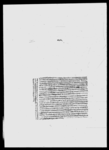A report by Candraśekhara Upādhyāya to General Bhīmasen Thāpā and Kājī Raṇadhvaja Thāpā on a meeting with the governor-general and on British-Maratha hostilities [VS 1874]
ID: DNA_0002_0085
Edited and
translated by Manik Bajracharya, Simon Cubelic, Rajan Khatiwoda
in collaboration with
Pabitra Bajracharya
Created: 2019-03-27;
Last modified: 2019-10-29
For the metadata of the document, click here
The accompanying edition, translation/synopsis and/or commentary are available under the terms of the Creative Commons Attribution-ShareAlike 4.0 International License
Abstract
This letter sent by the Nepalese envoy Candraśekhara Upādhyāya to General Bhīmasen Thāpā and Kājī Raṇadhvaja Thāpā reports about a) a meeting with Governor-General Hastings, b) Hastings's departure to Danapur due to events in Bharatpur, c) the serious sickness of Gajarāja Miśra, who was accompanying Candraśekhara on his diplomatic mission, d) the British-Maratha hostilities triggered by the alleged murder of Gangadhar Shastri by Trimbak Dengle in Pune.Diplomatic edition
[1r]
श्रीदुर्गा\
नं२०४1स्वस्तिश्रीसर्वोपमम्योग्यशौर्य्यौदार्य्यदयादाक्षिण्यादिगुणगणालंकृतराजभारसमर्थ2श्रीश्रीश्रीजनरलभीमसेनथापाश्रीश्रीश्रीकाजिरणध्वजथापाकेषुशुभेछुचंद्रशेख
3रउपाध्यायकोशुभाशीर्वादपूर्वकंपत्रं∙कृपालेञाहाँकुशलहोला∙ताँहांकोकुशल
4मंगलसर्वदाचाहियेआगेञाहांकोसमाचारभलोछउप्रान्त∙लाठसाहवञाहादाषि
5ल्भै∙हांमिसितभेटमुलाकात∙वात्चित्भयाकोविस्तार∙एतावाटअघिलेष्याका
6पत्रलेर∙एस्पालालेष्याका∙पार्सिहरफ्कापत्रलेजाहरहोला∙लाठसाहवले∙हामि
7सितभेटगर्याकातेस्रादिनएतावाटदानापुरकूचगर्या∙मेरापनिउन्कासाथज
8वाइभयेन∙कलकत्तैजाउभन्या∙मिश्रज्यूलाइऔलाकाविरामीलेदवाइराषेछ∙एस्
9तामाछोडिजानसकियेनर∙केहिदिन्ञाँहांरहिय़ाकोछ∙इन्लाइअलिक्आराम
10भयापछिकलकत्तातिरकूचगरूला∙षैषवरकाअर्थ∙एतिजल्दिगरीगयाकोकाम
11हिंदुस्तानीहरूभन्याभरत्पुरैकोअर्थकहन्छन्∙गोरासाहवानहरूछेउवुझ्दाभन्या∙हा
12मिलाइथाहाछैनभन्छन्∙षोलि∙कोहिकहँदैनन्∙पुनामा∙ढेक्लाभन्याका१सर्दा
13र∙इन्कापनाहका१आदमीलाइदगागरीमार्दा∙उहांकाअंगरेजहरूलेउस्लाइपक्रि
14कैदमा∙राष्याको∙कैदवाटभागिपुनामाआइ∙फोजकसीगरी∙हगामावढाउन्यापा
15ठगरेछर∙अंगरेजकोपनि∙उस्देहातमाभयाकोलस्करजमाभै∙पुनाघेरियेछप
16छिवाजीराव़ले∙योफसादउठाउन्या∙लाइतिमितलासगरीआफ्नाकैदमाराष∙हा
17मिलेतिमिसित∙तक्रारवढाउनुलड्नुछैनभनिबुझाउन्याकाम्गर्या∙आजकाल्∙अं
18गरेजकातरफ्वाट∙उस्कोतलासहुनलागीरहेछभन्न्याषवरएकवारकोसुनिन्
19छसाचोझुटो∙ताँहाँगारन्साहववाटथाहाहोला∙अरूञाहाँकोहाल्सूरतयथा
20स्थितैछ∙आजमिश्रज्यूलाइवेथालेदवायाकाछ∙अवकाशछैनपछिजोहो
21लासन्यापायाकोषवरविन्तिगरीपठाउँला∙विज्ञेषुकिमधिकमितिद्वितीयश्रा
22वणसुदि४रोज७मुकामपटनाशुभम्¯¯¯ ¯¯¯ ¯¯¯ ¯¯¯ ¯¯¯ ¯¯¯ ¯¯¯ ¯¯¯1ञाहाँकाहावा़लेमाफ्कनगरेनहाजिपुरतरफ्लैजानुभनिवैद्यहरुले
2भन्यार∙आजव़ाँहालैजान्याताकितगर्नलागीरह्याछौंव़ाहागयाप
3छीजस्तोहोलाविन्तिपठाउँलाशुभम्
Translation
[1r]
Glorious Durgā
No. 2041
Hail! This is a letter from your well-wisher Caṃdra Śekhara Upādhyāya with auspicious blessings to the thrice venerable General Bhīmasena Thāpā, who is adorned with a multitude of qualities—the worthiness [to be an object] of all [exalted] similes, heroism, generosity, compassion, skillfulness and the like—and who is able to shoulder royal duties; and to the thrice venerable kājīRaṇadhvaja Thāpā.
Things here will prosper with [your] favour. Your health and happiness are always desired [by me]. Furthermore, the tidings here are good.
Uprānta: The details of the meeting and conversation with us when Lord Sāheba2 came here will be known to you from the letter written previously from here and from the letter in Persian script written recently to you. On the third day after Lord Sāheba met us, he departed from here to Dānāpura3 . I did not accompany him. Concerning [my plans] to go to Calcutta: Miśra4 has been struck down by malaria. I could not go and leave him in such a condition, and [so] I have remained here for some days. I will depart to Calcutta once he is somewhat better.
[This is] the content of the news: the Hindustanis say that Bharatapura 5 is the reason for his hasty departure. When I ask the white sāhebas, they say: "We don't know." Nobody talks openly.
In Pune, 1 sardāra named Ḍheklā6 deceived and killed 1 person7 under the protection [of the British], and the English there seized hold of him and imprisoned him. He escaped from prison, came [back] to Pune, gathered an army and gave instructions that caused an uproar. The English, too, gathered their troops in the region and surrounded Pune. Later on, Bājī Rāva8 convinced [the English] by saying: "You look for the person who caused the uproar and imprison him yourself. We are not willing to intensify [our] dispute and engage in battle with you." It is heard that the English these days have launched a manhunt for him. The truth will be known through Gāran Sāheba9 . The rest of the news here is as before. Miśra is overpowered by his sickness today. There is no chance [for him].
Concerning what will happen later, I will forward to you the news I hear or receive.
What more to say to a knowledgeable one.
Saturday, the 4th of the bright fortnight of the second Śrāvaṇa [in the Vikrama era year 1874].10 Auspiciousness.
The atmosphere here is unforgiving. The physicians suggested taking him (i.e., Miśra) to Hājipura11 , and we are speeding up preparations to take him there. Regarding what happens once we get there, we will keep you informed. Auspiciousness.
Commentary
The present document provides insights into Nepal's diplomatic affairs after the Anglo-Nepalese War. It shows that the two major figures of the Nepalese foreign service during the war period, Candraśekhara Upādhyāya and Gajarāja Miśra, were still entrusted with diplomatic missions in Nepal and abroad at the highest level, e.g. in meetings with the governor-general or the British resident in Kathmandu (Rose 1971: 91). Gajarāja Miśra was destined for that role, having enjoyed the trust of the British already before his exile (Rose 1971: 75). In November 1815 he negotiated a peace settlement with Major P. Bradshaw, which, however, was not ratified by the Kathmandu darabāra (Rose 1971: 87). Together with Candraśekhara, he signed the Treaty of Sugauli (1816) on behalf of King Gīrvāṇayuddha (Stiller 1976: 22). Candraśekhara was dispatched to establish peace with the British from 1814 onwards (cf. Sanwal 1965: 180). According to P. Bradshaw, both Nepalese envoys were "favourably disposed to each other" (letter from P. Bradshaw to John Adam, 8 January 1814 in: Papers Regarding the Administration of the Marquis of Hastings in India, p. 388). In 1814 Candraśekhara became a prisoner of the Company government for a short time (Sanwal 1965: 200), but continued his diplomatic activities throughout the entire war period. The events reported in this letter are part of the prelude to the Third Anglo-Maratha War (1817–1818). Even though opportunities for diplomatic contacts between Nepal and the native states of India were restriced as a result of the Treaty of Sugauli, they were not entirely non-existent (Stiller 1976: 110). Now that British-Maratha tensions were growing, there were elements at the darabāra who were considering renewing hostilities with the British under the now more favourable circumstances (Rose 1971: 96). Therefore, it is no surprise that much space in Candraśekhara's report was devoted to the events in Pune.

